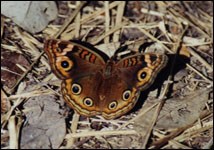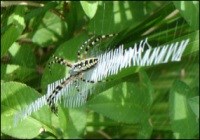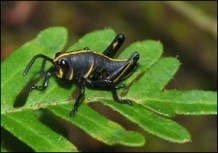|
It's clear that the the Everglades is home to large amazing animals like the alligator and manatee, but we can't forget the other fascinating residents.
Many of the Everglades’ other resident wildlife is often very small. Some can have curious behavior and others are uniquely beautiful. Let’s take a look at some of the insects of the Everglades. Whirligig beetles are often seen swimming as big groups in rapid, unpredictable circles, on the surface of bodies of water in the Everglades. They have divided eyes on their heads, two flattened ones on top and two curved ones on the bottom, which allow them to see both above and below water. They can dive underwater with help from an air bubble trapped under their abdomen or belly, which works like a lung and helps them to breathe. These beetles eat small insects that fall into the water as well as mosquito larvae. These truly amazing insects can fly, swim and dive!
NPS Photo 
NPS Photo The Yellow Garden Orb-Weaver (Argiope aurantia) is an arachnid you might come across when hiking in the Everglades. They spin large webs that catch small flying insects. The silk of this spider is gold colored! 
NPS Photo Lubber grasshoppers are easy to spot. These brightly colorful, and often large (up to 3 inches long), grasshoppers are unable to fly. They can usually jump short distances and often move quite slowly. They make up for this with some defensive characteristics. Their bright color does not camouflage them in their green surroundings; instead it warns potential predators that it is toxic to ingest or eat. Many small mammals and birds become sick and quickly learn not to try to eat this grasshopper anymore! Mosquitoes are by far the most fascinating insect in the Everglades. While they are annoyingly abundant during the summer wet season, their numbers diminish greatly during the cooler drier months of winter. This large number of mosquitoes increases in the wet season because eggs need to be laid in the water, and the larvae that hatch need to live in the water. While the male mosquitoes feed on flower nectar, the female mosquito bites mammals like us or other animals. She needs the proteins from the blood to develop and nourish her eggs. Mosquitoes are attracted to the carbon dioxide we breathe out, and because other oxygen breathing animals omit the same carbon dioxide, they also attract biting mosquitoes. Some mosquitoes prefer biting birds and can even bite alligators! To return to the previous page click on Wildlife and to return to the main |
Last updated: January 3, 2018
